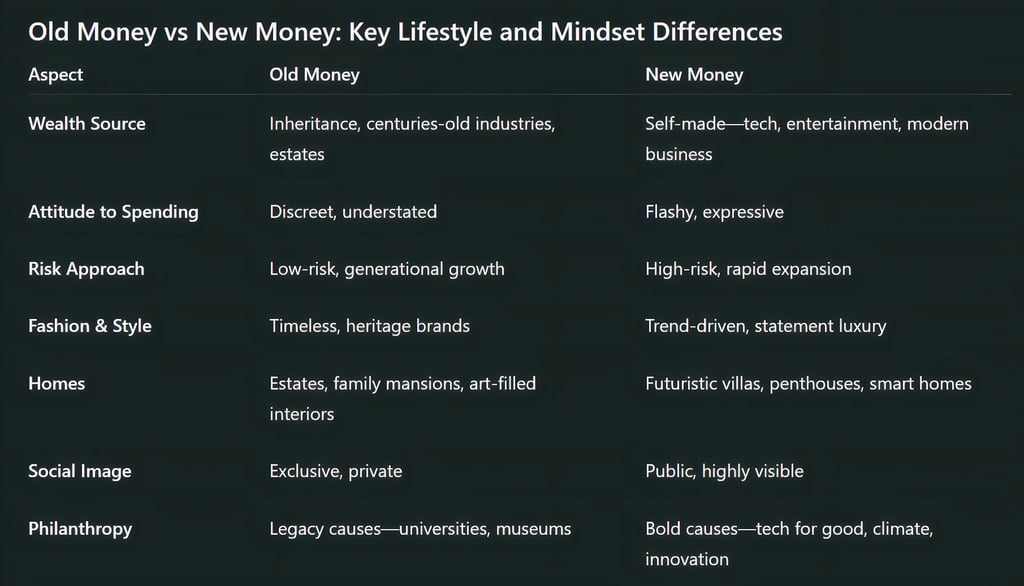
Old Money vs New Money: Hidden Mindsets, Lifestyles, and Power Dynamics
Discover the hidden mindsets and lifestyles of Old Money vs New Money. Explore their psychology, spending habits, fashion, and values shaping modern wealth.
A LEARNINGTHE GREAT LEADERBANKING/CASH-FLOW
---
10/11/20255 min read


Money shapes culture, but not all wealth is created—or lived—the same way. On one side are the Old Money dynasties, whose fortunes are woven into history, tradition, and legacy. On the other side stands New Money, the wealth of innovation, celebrity, and hustle. While both command financial power, their hidden mindsets, lifestyles, and social codes set them apart. Understanding these differences isn’t just about luxury—it’s about psychology, identity, and the invisible rules of class.
Old Money: Legacy Above All
Old Money families see wealth as a responsibility, not just a privilege. They are custodians of a legacy built generations ago, and their greatest fear is losing it. This explains their cautious approach to spending and their obsession with reputation.
Psychological Traits
Avoid showiness to maintain exclusivity.
Value discipline, privacy, and family honor.
Carry an ingrained belief in social hierarchy and duty.
Examples of Old Money Families
Europe: The Rothschild banking family, British aristocracy, and French nobility.
United States: Rockefellers, Vanderbilts, Du Ponts.
India: Tata, Birla, and other industrial legacies.
Hidden Lifestyle Codes
Private clubs, polo, yachting, and art auctions.
Subtle luxury: linen shirts, vintage watches, and muted color palettes.
Avoid Instagram displays—true wealth, in their view, whispers rather than shouts.
New Money: Wealth in Motion
New Money thrives on visibility, speed, and the celebration of the self-made story. These individuals come from humble beginnings, build empires, and wear their success proudly.
Psychological Traits
Value innovation and bold risk-taking.
Believe money should be enjoyed and shared publicly.
Define success through recognition and influence.
Examples of New Money Figures
Global: Elon Musk, Jeff Bezos, Oprah Winfrey, Cristiano Ronaldo.
India: Mukesh Ambani (Reliance), Shah Rukh Khan, and the tech founders of Flipkart and Paytm.
Hidden Lifestyle Codes
Public charity events, red-carpet appearances, and luxury social media presence.
Collecting supercars, building glass mansions, and private jets.
Cutting-edge investments—crypto, AI, space travel.
Fascinating Facts About Old Money vs New Money
Silent Codes of Wealth: Old Money families often practice “stealth wealth”—avoiding flashy logos and showing wealth through quality, not quantity. For example, a simple navy blazer from Brooks Brothers may signal more wealth than a logo-heavy Gucci jacket.
Generational Decline Rule: Sociologists often cite the proverb “shirtsleeves to shirtsleeves in three generations”—meaning wealth created by one generation is often spent away by the third. Old Money avoids this through strict planning and traditions.
Yachts vs Estates: New Money is more likely to buy superyachts and private jets. Old Money invests in estates, vineyards, and art collections that hold cultural value.
Education as a Status Symbol: Old Money sends children to legacy schools like Eton, Harvard, or Oxford. New Money often experiments with modern education—or even starts their own schools and foundations.
Fashion Psychology: Old Money prefers muted colors because they signal confidence without needing validation. New Money embraces bold, flashy designs because they represent visibility and personal branding.
Regional Differences:
In the U.S., Old Money is often tied to East Coast families (Boston, New York), while New Money thrives in Silicon Valley and Hollywood.
In India, Old Money (Tatas, Birlas) shaped industries, while New Money (Ambanis, tech founders) drives modern expansion.
In the Middle East, Dubai and Qatar are classic New Money examples, transforming oil wealth into futuristic megacities.
Philanthropy Strategy: Old Money philanthropy often stays anonymous to maintain dignity. New Money philanthropy is public, used as a form of personal or corporate branding.
Luxury Travel Styles: Old Money tends to holiday in private villas, countryside estates, or heritage clubs. New Money books entire islands, space tourism experiences, or ultra-luxury resorts.



Family and Cultural Differences
Family Structure
Old Money: Children are groomed for responsibility—elite education, etiquette, and business legacy.
New Money: Children are often exposed to fast-changing luxury and media attention, sometimes creating pressure to maintain status.
Cultural Behavior
Old Money avoids controversy and maintains a polished public image.
New Money thrives on personal branding—controversy can even boost their influence.
Global Dynamics
In the West, Old Money dominates politics and elite networks.
In Asia, rapid New Money growth is reshaping cities—think Dubai, Singapore, and Mumbai.
In Africa, New Money entrepreneurs are emerging as tech leaders, while Old Money families control traditional resources.
The Blurred Lines of Modern Wealth
The 21st century is reshaping what it means to be wealthy. New Money individuals often seek legitimacy by adopting Old Money habits—sending children to legacy schools, collecting art, or joining private clubs. Meanwhile, Old Money families are learning from New Money’s embrace of media and branding to stay culturally relevant.
This blending shows that the future of wealth is hybrid: combining Old Money’s preservation with New Money’s boldness.
The Hidden Struggles Behind the Wealth
Old Money Struggles: Pressure to maintain tradition, fear of losing status, and resistance to change.
New Money Struggles: Criticism for being “too flashy,” social rejection from elite circles, and the challenge of turning fast success into a lasting legacy.
Lessons for Everyone
From Old Money: The art of discretion, long-term planning, and valuing legacy over temporary trends.
From New Money: The courage to innovate, embrace visibility, and create opportunities beyond tradition.
Together, they reveal that true wealth lies not only in what you own but in how you use it—for family, society, and future generations.
Old Money and New Money are more than financial categories—they are cultural codes, psychological worlds, and lifestyle philosophies. Old Money reminds us that wealth is responsibility and continuity, while New Money shows us the power of reinvention and bold living. In today’s globalized era, both paths are converging, proving that wealth’s true legacy is mindset, not money.

Frequently Asked Questions
Q. What is the main difference between Old Money and New Money?
Old Money wealth is inherited and preserved across generations, while New Money is self-made, often built in one lifetime through business, tech, or entertainment.
Q. Why is Old Money considered more “elite” than New Money?
Old Money families have long-standing traditions, private networks, and cultural influence. Their exclusivity comes not just from wealth, but from heritage, education, and connections passed down for centuries.
Q. Is New Money less respected in society?
Not always. While Old Money circles may look down on flashy displays, New Money is admired for ambition, innovation, and self-made success. Many New Money billionaires are shaping the modern economy in ways Old Money never could.
Q. Do Old Money and New Money spend differently?
Yes. Old Money prefers discreet investments like art, land, or heritage brands. New Money leans toward bold spending—luxury cars, high-tech mansions, global experiences, and social media-worthy lifestyles.
Q. Can New Money eventually become Old Money?
Absolutely. After a few generations, New Money families often adopt Old Money values—focusing on legacy, private clubs, heritage education, and quieter lifestyles. Think of it as wealth maturing over time.
Q. How do fashion choices differ between Old Money and New Money?
Old Money sticks to timeless classics—neutral colors, pearls, blazers, and heritage brands. New Money embraces trends—designer logos, luxury streetwear, bold jewelry, and social media-driven fashion.
Q. Which group is more philanthropic?
Both are generous but in different ways. Old Money supports traditional causes like universities, hospitals, and the arts. New Money leans toward modern causes—climate change, space exploration, education technology, and healthcare innovation.
Q. How does social media affect Old vs New Money lifestyles?
New Money thrives on visibility—Instagram, TikTok, and YouTube amplify their brand. Old Money avoids oversharing, preferring private circles and low profiles.
Q. Which is more stable: Old Money or New Money?
Old Money is usually more stable because of generational planning and conservative investments. New Money can be volatile, especially if built in fast-changing industries like tech, sports, or entertainment.
Q. What lessons can ordinary people learn from Old and New Money?
From Old Money: long-term thinking, financial discipline, and subtlety.
From New Money: innovation, boldness, and living life fully. Combining both creates a balanced approach to wealth and success.
Subscribe to our newsletter
All © Copyright reserved by Accessible-Learning
| Terms & Conditions
Knowledge is power. Learn with Us. 📚


